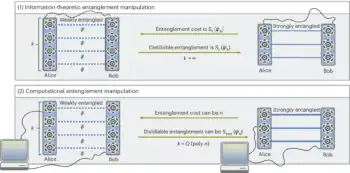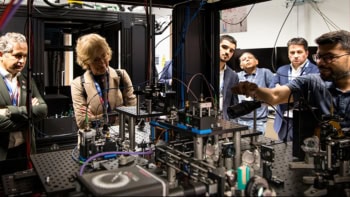One of the most unusual predictions of quantum mechanics is that, under certain conditions, individual particles can have no real properties of their own. Surprising as it seems, this so-called lack of local realism has been confirmed many times in experiments with pairs of photons. It has now been confirmed for the first time in experiments with three-photon states (J-W Pan et al. 2000 Nature 403 515).
The conflict between quantum theory and local realism can be traced back to the work of Schrödinger and Einstein, Podolsky and Rosen in 1935. It remained a philosophical matter until the 1960s when John Bell suggested experiments that could distinguish between quantum theory and local realistic theories. These experiments typically involved creating pairs of photons and measuring the correlations between their polarizations when they were widely separated.
The first experiments were carried out in 1982 and confirmed the predictions of quantum theory. In other words, the photons in the experiment did not have individual or local properties, such as their own polarizations, until that property was measured. This was different from particles having properties that experimentalists could not measure: the individual particles did not have any properties in the first place. Local realistic theories which assumed that each photon had a polarization from the instant it was created did not agree with the experimental results.
However, some physicists pointed out various loop-holes in these experiments. Over the years these loop-holes have been closed (for example, by measuring the polarizations at ever-greater separations), and quantum theory remained triumphant. One particular loop-hole was that the photon-pair experiments relied on a statistical average of many measurements: it was therefore necessary to assume that the photons detected were a “fair sample”.
In 1989 Daniel Greenberger, Michael Horne and Anton Zeilinger (GHZ) proposed an experiment with a three-photon state for which quantum mechanics and local realistic theories gave completely different predictions for a single measurement. Zeilinger and colleagues at the universities of Vienna, Oxford and Munich have now performed such an experiment and confirmed, once again, the predictions of quantum theory.
The experiment involves creating two pairs of infrared photons from the interaction of a short pulse of ultraviolet light and a crystal with nonlinear optical properties. The photons travel through an arrangement of beam-splitters, filters, polarizers and other optical components to four detectors. The experiment is arranged such that when all four detectors register a photon at the same time, three of them are in a GHZ state.
Since a polarization measurement on a photon can give one of two results, measurements on three photons can yield one of eight different results. Quantum theory predicts that only four of these results are possible when a certain measurement is made on a GHZ state, while local realistic theories predict that the same measurement will always yield one of the four remaining results. Zeilinger and co-workers find that, within experimental error bars, quantum theory is correct.



